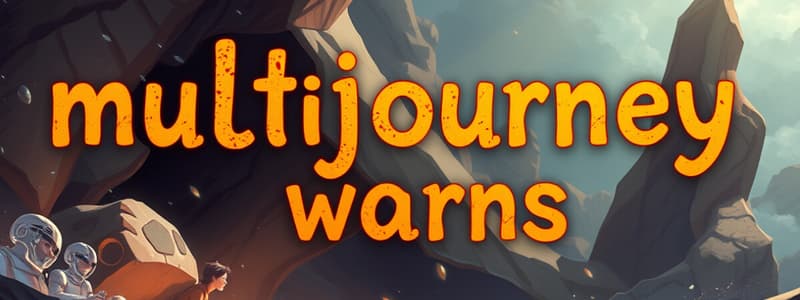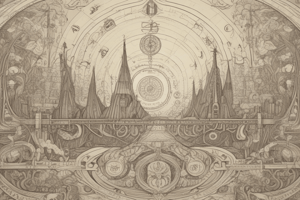Podcast
Questions and Answers
What should be the first step in the five-step reading process?
What should be the first step in the five-step reading process?
- Paraphrase the text
- Preview the text for important information
- Picture the text in your own words
- Prepare yourself and your environment (correct)
What is the purpose of using context clues when encountering unfamiliar words?
What is the purpose of using context clues when encountering unfamiliar words?
- To avoid reading the word altogether
- To assist in recognizing and understanding new words (correct)
- To memorize the word for future use
- To determine the spelling of the word
What does it mean when a main idea is described as 'implied'?
What does it mean when a main idea is described as 'implied'?
- It is suggested and not directly stated (correct)
- It is irrelevant to the narrative
- It is stated directly in the text
- It is the primary theme of the story
Which strategy is NOT recommended for determining the main idea after reading a story?
Which strategy is NOT recommended for determining the main idea after reading a story?
How can breaking down a multisyllabic word aid in pronunciation?
How can breaking down a multisyllabic word aid in pronunciation?
What should you avoid confusing with the main idea of a story?
What should you avoid confusing with the main idea of a story?
What is a valuable technique to aid in reading comprehension according to the summary?
What is a valuable technique to aid in reading comprehension according to the summary?
What is the primary difference between the main topic and the central theme of a story?
What is the primary difference between the main topic and the central theme of a story?
Which of the following strategies is essential when writing a summary?
Which of the following strategies is essential when writing a summary?
What skill is utilized when the reader infers information that is not explicitly stated in the text?
What skill is utilized when the reader infers information that is not explicitly stated in the text?
When comparing texts, what is the focus of the analysis?
When comparing texts, what is the focus of the analysis?
What is the purpose of analyzing cause and effect in a text?
What is the purpose of analyzing cause and effect in a text?
What is the key difference between comparing and contrasting elements in a text?
What is the key difference between comparing and contrasting elements in a text?
Which of the following statements best defines a fact?
Which of the following statements best defines a fact?
What does literary analysis primarily involve?
What does literary analysis primarily involve?
What is the primary function of drawing conclusions while reading?
What is the primary function of drawing conclusions while reading?
What are the two main categories of fiction writing?
What are the two main categories of fiction writing?
Which of the following is NOT a characteristic of expository texts?
Which of the following is NOT a characteristic of expository texts?
What type of poetry is primarily focused on storytelling?
What type of poetry is primarily focused on storytelling?
In a formal essay, where is the thesis statement typically located?
In a formal essay, where is the thesis statement typically located?
Which of the following best describes literary nonfiction?
Which of the following best describes literary nonfiction?
What distinguishes a biography from an autobiography?
What distinguishes a biography from an autobiography?
Which literary genre is characterized by the use of dialogue for storytelling?
Which literary genre is characterized by the use of dialogue for storytelling?
What is the primary purpose of a compare and contrast essay?
What is the primary purpose of a compare and contrast essay?
Which is an example of a sub-genre of drama?
Which is an example of a sub-genre of drama?
Flashcards are hidden until you start studying
Study Notes
Multisyllabic Words and Spelling
- Multisyllabic words consist of more than one syllable or vowel sound.
- Basic spelling patterns help decode pronunciation.
- Pay attention to vowels, consonants, and affixes (prefixes and suffixes).
Purposeful Reading Process
- Follow a five-step process for effective reading: prepare environment, preview text, predict, paraphrase, and visualize.
- Understanding the text enhances purposeful reading.
Context Clues
- Use surrounding words to figure out the meaning of unfamiliar words.
- Context clues help decode new vocabulary effectively.
Main Idea in Literature
- The main idea is the central concept within a narrative.
- It can be explicit (stated) or implicit (implied).
- Strategies for identifying the main idea include looking for the main problem, patterns, character insights, summarization, and re-reading key parts.
Summary Writing
- Summarize by answering the who, what, when, where, why, and how.
- Provide a topic sentence with the main theme and include relevant details while omitting unnecessary information.
Paraphrasing
- Paraphrasing involves rewording someone else's ideas while maintaining original meaning.
- It allows the integration of external information into one's own writing responsibly.
Making Inferences
- Inferences derive from existing knowledge combined with textual evidence to fill in missing information.
- Use inference to enhance understanding of stories and images.
Drawing Conclusions
- Conclusions are deductions based on reasoning about character feelings and events that are not directly stated.
- Integrate personal knowledge and experiences for informed conclusions.
Comparing vs. Contrasting
- Comparing identifies similarities; contrasting identifies differences.
- Use keywords and specific strategies for effective comparison.
- Utilize nonfiction sources for accurate comparisons.
Making Inferences from Diagrams
- Inferences from diagrams combine visual details with prior knowledge to uncover hidden information.
Literary Response and Analysis
- Literary response refers to personal reactions to literature.
- Literary analysis examines how text elements create meaning.
- Utilize textual evidence and analyze story elements for deeper understanding.
Facts vs. Opinions
- Facts can be proven true; opinions are subjective and based on personal beliefs.
- Assess statements using questions about their provability and whether they reflect personal feelings.
Cause and Effect Relationships
- Identify cause and effect by looking for signal words in text.
Comparing and Contrasting Elements
- Analyze characters, settings, and conflicts using Venn diagrams or T-charts.
- Develop comparative thinking for better text comprehension.
Understanding Genre
- Genres categorize literary works based on specific characteristics: poetry, fiction, nonfiction, and drama.
- Poetry expresses emotions; fiction presents invented narratives; nonfiction shares factual information; drama is performed.
Types of Fiction
- Genre fiction (commercial) is plot-driven, while literary fiction focuses on deeper meanings.
- Fiction forms: short stories (<30 pages), novellas (60-120 pages), and novels (120+ pages).
Understanding Nonfiction
- Nonfiction encompasses factual writing, divided into informational (conveying facts) and literary (using literary elements).
- Biographies and autobiographies document real-life stories from third-person and first-person perspectives, respectively.
Expository Texts
- Expository texts aim to inform, contrasting with narrative texts.
- Present structured, factual information using clear language.
Formal Essay Structure
- Formal essays consist of an introduction, several body paragraphs, and a conclusion.
- The thesis statement summarizes the essay and is placed at the end of the introduction.
Persuasion in Journalism
- Journalists employ persuasive techniques, such as rhetorical questions, testimonials, emotional appeals, persuasive pronouns, and expert opinions, to influence audiences.
Folklore and Myths
- Folklore encompasses stories and customs passed down generations, preserving cultural beliefs.
- Myths explore cultural origins and worldviews through storytelling.
Elements of Poetry
- Include various poetic forms, meter, rhyme schemes, and stanzas to convey ideas.
- Concrete poetry combines visual and literary elements to deepen meaning.
Dramatic Monologues
- Dramatic monologues allow characters to express motivations and thoughts.
- Famous examples highlight the depth and variety of monologues in literature.
Studying That Suits You
Use AI to generate personalized quizzes and flashcards to suit your learning preferences.




